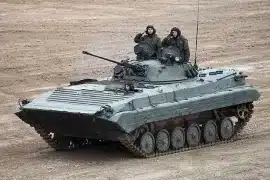The Dhanush, an Indian 155 mm field howitzer, represents a significant leap forward in India’s artillery capabilities. Based on the Swedish FH-77B, supplied to India between 1986 and 1991, it boasts a rich lineage of technology transfer and enhancement. With the need for replacements due to the aging FH-77Bs and unsuccessful attempts to procure artillery systems from other countries, the Dhanush emerged as a crucial addition to the Indian Army’s arsenal.
Dhanush Howitzer: Prominent Features
The development of the Dhanush howitzer unfolded between 2010 and 2013 as a homegrown solution to replace not only the FH-77B but also the older Indian Field Gun, Light Field Gun, and Soviet D-30 howitzers.

While the Dhanush shares its roots with the FH-77B, it features a longer ordnance and several other improvements aimed at enhancing its performance.
Dhanush Howitzer: Technical Parameters
Here is a table highlighting the technical parameters of the Dhanush Howitzer:
| Parameters | Specifications |
| Calibre | 155mm/45 CAL |
| Chamber Capacity | 23 Litres |
| Range | >36 Kms |
| Ammunition Types | ERFB BB, ERFB BT, HEER, HE 77B, SMOKE (ER), ILLUMINATION (ER) |
| Charge System | Bi-Modular Charge System and Bag Charge System |
| Direct Firing | Day and night capability with a unified direct aiming sight comprising of day camera, T.I. sight & eye-safe L.R.F. |
| Rate of Firing | Burst : 3 RDS in 30s Intense : 12 RDS in 3 min |
| Accuracy | ≤ 1.0% |
| Towed | 70Kmph |
| Self-propelled | >5kmph |
Triumphant Trials and Adoption
In 2016, the Indian Army received the first Dhanush howitzers for rigorous trials and evaluation. During these tests, they outperformed the Bofors FH-77B howitzers by a significant margin, boasting a 20-25% advantage in terms of range and accuracy. This outstanding performance led to the official approval for series production in 2019, with subsequent adoption by the Indian Army. An initial order of 114 units marked the beginning of its operational deployment.
Technical Prowess
The Dhanush howitzer stands out with its auxiliary power unit and integrated steering system. This power unit facilitates self-propulsion on roads and in various positions, as well as ammunition loading, emplacement, and displacement.
Extended Range Firepower
Armed with a 155 mm/L45 ordnance, the Dhanush offers an extended range compared to the FH-77B, thanks to its longer barrel. It is compatible with standard NATO 155 mm ammunition, including high explosive, smoke, illuminating, and cargo shells. With a range of up to 38 km, the Dhanush can also utilize US Excalibur extended-range GPS-guided shells, boasting precision with a range of 40 km and a 5-meter accuracy.
Maneuverability and Automation
The Dhanush features a split trail carriage, enabling wide angles of traverse and elevation. Equipped with a hydraulic crane, it efficiently loads ammunition packs, each containing three shells. While charges are loaded manually, a sophisticated automatic load-assisting system ensures the smooth ramming of both shells and propellant charges at any elevation. However, manual hydraulic pumps offer a backup in case of power unit failure.
Rapid Fire Capability
The Dhanush can deliver a burst of three shells within 15 seconds, showcasing its ability for rapid engagement. A well-trained crew of two can emplace and fire the howitzer at a rate of up to 12 rounds per minute, with a sustained rate of fire of one round per minute.
Advanced Fire Control and Crew Efficiency
Equipped with an automatic gun laying system and a tactical computer for ballistic calculations, the Dhanush streamlines target acquisition and firing solutions. Operating with a crew of 6-8 members, the howitzer takes a mere 1-2 minutes to emplace or exit the firing position, ensuring operational agility.
Versatile Mobility
Powered by an auxiliary power unit generating 127 hp, the Dhanush can achieve a maximum road speed of approximately 18 km/h. While it possesses auto-propulsion capabilities for short distances, it is typically towed by a 6×6 military truck. Notably, India recently adopted the Ashok Leyland FAT artillery tractor, featuring a 6×6 configuration, additional crew cabs, and ammunition storage, further enhancing the Dhanush’s mobility.
Variants and Indigenous Excellence
India’s Dhanush howitzer program boasts an impressive 81% indigenous content, facilitating ease of maintenance and spare parts availability. Additionally, the Mounted Gun Howitzer, a self-propelled variant mounted on a Tatra 8×8 military truck chassis, enhances tactical mobility.
Summary of “Dhanush Howitzer”
In conclusion, the Dhanush howitzer stands as a testament to India’s commitment to developing indigenous artillery capabilities. With its extended range, rapid fire capability, and advanced automation, it serves as a versatile and potent asset for the Indian Army. As it continues to be integrated into the armed forces, the Dhanush exemplifies India’s dedication to enhancing its defense capabilities while maintaining self-reliance in its military technology.
Dhanush Howitzer: FAQs
Here is a compilation of common inquiries regarding the Indian Dhanush Howitzer, along with their corresponding answers.
1. What is the significance of the Dhanush howitzer for the Indian Army?
The Dhanush howitzer holds immense significance for the Indian Army. It represents a vital step towards modernizing and strengthening India’s artillery capabilities. Developed to replace aging artillery systems, including the FH-77B, the Dhanush enhances the army’s firepower, accuracy, and range, enabling it to effectively address evolving threats and operational requirements.
2. How does the Dhanush howitzer compare to its predecessor, the FH-77B?
The Dhanush howitzer exhibits several improvements over its predecessor, the FH-77B. Most notably, it features a longer barrel, resulting in extended range and enhanced accuracy, surpassing the FH-77B by approximately 20-25%. These enhancements significantly improve the Indian Army’s ability to engage distant targets with precision.
3. What is the production status of the Dhanush howitzer, and how many have been ordered for the Indian Army?
As of the latest information available, the Dhanush howitzer was approved for series production in 2019. The Indian Army initially ordered a total of 114 units, with small-scale deliveries commencing in 2019.
4. Can the Dhanush howitzer be used in various terrains and conditions?
Yes, the Dhanush howitzer ensures versatility and adaptability. It can operate effectively in a wide range of terrains and conditions, showcasing its mobility and tactical flexibility. Whether in rugged terrain or varied environmental settings, the Dhanush can meet the Indian Army’s diverse operational needs.
5. Are there plans for further developments or variants of the Dhanush howitzer?
While specific information on future developments may be subject to change, India’s commitment to enhancing its artillery capabilities remains steadfast. The Dhanush howitzer program represents an indigenous success story. The possibility of upgrades or variants in the future depends on India’s ongoing efforts to modernize its defense infrastructure. Stay tuned for updates from official sources regarding any potential advancements in the Dhanush howitzer program.







